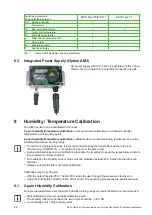
20
EE33 Humidity / Temperature Sensor for High Humidity and Chemical Applications
6.5 Connection Configuration of Connectable Sensing Probe (Option PC6)
9-pole terminal
∅
12 mm
(0.5")
sensing probe:
grey
shielding
shielding (yellow/green)
grey (yellow/green
)
brown
yellow
blue
black
pink
5-pole terminal
shielding
blue
grey
black
brown
∅
6 mm
(0.25")
sensing probe:
7 Operating Components
7.1 Circuit Board
1.
Current/voltage output:
If the sensor will be switched from current to voltage output signals
using the configuration software, then two jumpers must also be
positioned as follows:
for current signal:
for voltage signal:
2.
RS232/RS485:
jumper set - RS232:
jumper removed - RS485:
3.
Fitting of the network chip:
For refitting to RS485, an IC must be used (available as option J3
or via accessory HA010605).
The notch on the chip must match the receiver slot!
4.
Display:
Pinboards for connecting the display module.
5.
Diagnosis LEDS:
refer to
chapter 9 “Humidity / Temperature Calibration”
refer to
chapter 10.4 “Self Diagnosis and Error Messages”
6.
Push-button (
heated measurement cell
): refer to
chapter 10.2 “Automatic ReCovery (ARC)”
7.
Push-buttons (calibration):
refer to
chapter 9 “Humidity / Temperature Calibration”
After removal of the enclosure cover, the following operating components on the circuit board may be
accessed.
1. current/voltage output
4. display
5. diagnosis LEDs
7. push-buttons (calibration)
6. push-button (heated measurement cell)
2. RS232/RS485
3. fitting of the
network chip






























